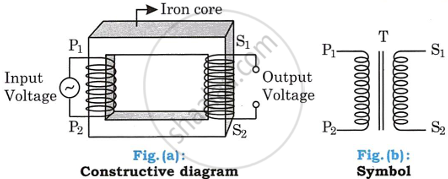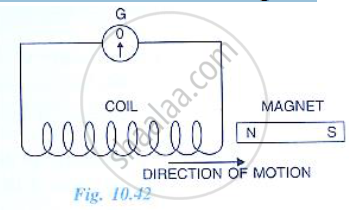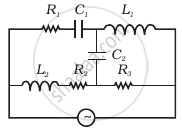Advertisements
Advertisements
Question
Explain the construction and working of the transformer.
Solution
Construction: It consists of two coils of primary and secondary coils insulated from each other and wound on a soft iron core as shown in fig. (a). Input is applied across the primary coil, and output is taken across the secondary coil.

Notations:
P1, P2: Primary coil
S1, S2: Secondary coil
There are two types of transformers:
- Step-up transformer: In this, the number of turns in the primary coil is less than the number of turns in the secondary coil. The primary coil is made up of thick wire, and the secondary coil is made up of thin wire.
- Step-down transformer: Here the number of turns in the primary coil is greater than that in the secondary coil. The secondary coil is made up of thick wire, and the primary coil is of thin wire.
Working: When an AC voltage is applied to the primary coil, the current through the coil goes on changing. Hence the magnetic flux through the core also changes. As this changing magnetic flux is linked with both coils, an emf is induced in each coil. The amount of magnetic flux linked with the coil depends upon the number of turns of the coil.
APPEARS IN
RELATED QUESTIONS
State the principle on which transformer works.
Write the function of a transformer.
A group of students while coming from the school noticed a box marked "Danger H.T. 2200 V" at a substation in the main street. They did not understand the utility of a such a high voltage, while they argued, the supply was only 220 V. They asked their teacher this question the next day. The teacher thought it to be an important question and therefore explained to the whole class.
Answer the following questions:
(i) What device is used to bring the high voltage down to low voltage of a.c. current and what is the principle of its working ?
(ii) Is it possible to use this device for bringing down the high dc voltage to the low voltage? Explain
(iii) Write the values displayed by the students and the teacher.
State the principle of the step-down transformer and its working.
Express the turn ratio in terms of voltages.
The teachers of Geeta’s school took the students on a study trip to a power generating station, located nearly 200 km away from the city. The teacher explained that electrical energy is transmitted over such a long distance to their city, in the form of alternating current (ac) raised to a high voltage. At the receiving end in the city, the voltage is reduced to operate the devices. As a result, the power loss is reduced. Geeta listened to the teacher and asked questions about how the ac is converted to a higher or lower voltage.
1) Name the device used to change the alternating voltage to a higher or lower value. State one cause for power dissipation in this device.
2) Explain with an example, how power loss is reduced if the energy is transmitted over long distances as an alternating current rather than a direct current.
3) Write two values each shown by the teachers and Geeta.
On which type of current do transformers work?
You are required to make an electromagnet from a soft iron bar by using a cell, an insulated coil of copper wire and a switch. (a) Draw a circuit diagram to represent the process. (b) label the poles of the electromagnet.
State two ways through which the strength of an electromagnet can be increased.
Complete the following sentence :
……… energy is converted into …………energy by an electric motor.
Name the phenomenon ?
The following diagram in Fig.10.42 shows a coil of several turns of copper wire connected to a sensitive centre zero galvanometer G near a magnet NS. The coil is free to move in the direction shown in the diagram.

(i) Describe the observation if the coil is rapidly moved.
(ii) How would the observation be altered if (a) the coil has twice as many turns (b the coil was made to move three times as fast?
Why is the iron core of a transformer made laminated (thin sheets) instead of being in one solid piece?
In a transformer, the frequency of A.C. voltage ______.
The input and output voltage of a transformer are 220 V and 44 V respectively. Find: the turns ratio.
Given the input current 15 A and the input voltage of 100 V for a step-up transformer having 90% efficiency, find the output power and the voltage in the secondary if the output current is 3 A.
State the principle of a step-up transformer. Explain, with the help of a labeled diagram, its working ?
Draw a labeled diagram of a full wave rectifier circuit. State its working principle. Show the input-output waveforms ?
Describe briefly, with the help of labelled diagram, working of a step-up transformer.
A step-up transformer converts a low voltage into high voltage. Does it not violate the principle of conservation of energy? Explain.
What is the ideal transformer?
State the principle of a transformer.
State the factors on which the frequency of the alternating e.m.f. depends.
Name the principle on which functioning of a transformer depends.
Copy the given diagram of a transformer and complete it. Name the parts A and B. Name the part you have drawn to complete the diagram. What is the material of this part? Is this transformer a step-up or step-down? Give reason.
A transformer lowers e.m.f. from 220 V to 15 V. If 400 W power is given in primary, calculate (i) the current in primary coil and (ii) the current in secondary coil.
A transformer lowers e.m.f. from 220 V to 15 V. If the number of turns in primary are 3520, how many turns are in the secondary coil?
The primary and secondary coils of a transformer each have an inductance of 200 x 10-6 H. The mutual inductance between the windings is 4 x 10-6 H. What percentage of the flux from one coil reaches the other?
An ideal transformer has 100 turns in the primary and 250 turns in the secondary. The peak value of the AC is 28 V. The rms secondary voltage is nearest to ______
Describe the construction and working of a transformer with a neat labelled diagram.
Devices which is used to convert high alternating current to low alternating current is ______.
In a series resonant RLC circuit, the voltage across 100 Ω resistor is 40 V. The resonant frequency ω is 250 rad/s. If the value of C is 4 µF, then the voltage across L is
What are step-up and step-down transformers?
Mention the various energy losses in a transformer.
A step-down transformer connected to the main supply of 220 V is used to operate 11V,88W lamp. Calculate
- Voltage transformation ratio and
- Current in the primary
The 300 turn primary of a transformer has resistance 0.82 Ω and the resistance of its secondary of 1200 turns is 6.2 Ω. Find the voltage across the primary if the power output from the secondary at 1600V is 32 kW. Calculate the power losses in both coils when the transformer efficiency is 80%
A step-up transformer has 300 turns of primary winding and 450 turns of secondary winding. A primary is connected to 150 V and the current flowing through it is 9A. The current and voltage in the secondary are
Read the following paragraph and answer the question:

Long distance power transmissions
The large-scale transmission and distribution of electrical energy over long distances is done with the use of transformers. The voltage output of the generator is stepped up. It is then transmitted over long distances to an area sub-station near the consumers. There the voltage is stepped down. It is further stepped down at distributing sub-stations and utility poles before a power supply of 240 V reaches our homes.
Which of the following statement is true?
Read the following paragraph and answer the question:

Long distance power transmissions
The large-scale transmission and distribution of electrical energy over long distances is done with the use of transformers. The voltage output of the generator is stepped up. It is then transmitted over long distances to an area sub-station near the consumers. There the voltage is stepped down. It is further stepped down at distributing sub-stations and utility poles before a power supply of 240 V reaches our homes.
We need to step-up the voltage for power transmission, so that ______.
Define a Transformer.
A step-down transformer connected to an ac mains supply of 220 V is made to operate at 11 V, 44 W lamp. Ignoring power losses in the transformer, what is the current in the primary circuit?
The line that draws power supply to your house from street has ______.
- zero average current.
- 220 V average voltage.
- voltage and current out of phase by 90°.
- voltage and current possibly differing in phase `phi` such that `|phi| < pi/2`.
Draw the effective equivalent circuit of the circuit shown in figure, at very high frequencies and find the effective impedance.

A 60 W load is connected to the secondary of a transformer whose primary draws line voltage. If a current of 0.54 A flows in the load, what is the current in the primary coil? Comment on the type of transformer being used.
Magnetic flux passing through a coil is initially 4 × 10-4 Wb. It reduces to 10% of its original value in t second. If the emf induced is 0. 72 mV then t in second is ______.
The primary coil having NP turns of an ideal transformer is supplied with an alternating voltage VP. Obtain an expression for the voltage VS induced in its secondary coil having NS turns.
Mention two main sources of power loss in real transformers.
The self-inductance of a closely wound coil of 200 turns is 10 mH. Determine the value of magnetic flux through the cross-section of the coil when the current passing through the coil is 4 mA.
The primary coil of a transformer has 60 turns whereas its secondary coil has 3000 turns.
If a current of 5A flows in the primary coil, how much current will flow in a load in the secondary coil? State the assumption you have made regarding the transformer, in this calculation.
What is a transformer?
